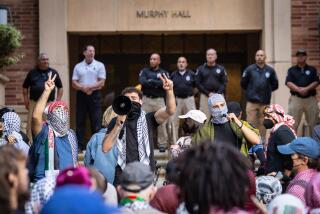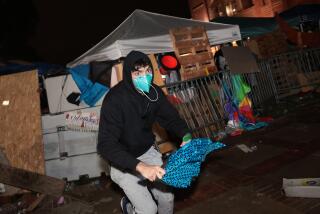Massive Show of Force Draws Praise and Jeers : Law enforcement: Many welcome extra officers. But some areas view heavily armed police as invading army.
- Share via
This time, the police were everywhere.
After an anxious night awaiting decisions in the Rodney G. King civil rights trial, Los Angeles awoke Saturday to the largest preventive mobilization of law enforcement in city history.
About 3,200 Police Department officers were on the streets an hour before the federal court verdicts were read--nearly 10 times the typical patrol strength. The county Sheriff’s Department quadrupled its normal 350-deputy field force, and several other Los Angeles County police departments were also fully deployed. Hundreds more law enforcement and National Guard personnel were standing by in specially trained reserve units across Southern California.
This massive show of force, costing at least $5 million in Los Angeles County alone, stood in dramatic contrast to the slow, disjointed response to the riots that arose last year after not guilty verdicts in the King beating case were returned in the state trial.
Because two LAPD officers were convicted Saturday of violating King’s civil rights, it is difficult to gauge just how much the law enforcement buildup helped ensure calm.
But it was clear that the police presence stirred a clash of emotions across the Southland. In some areas the police relieved anxiety among residents and were warmly welcomed. In some others, the heavily armed officers tended to be viewed as an invading force and were met with ridicule and contempt.
Los Angeles Police Chief Willie L. Williams strongly defended his strategy, saying that it had helped deter troublemakers and curb crime.
Williams’ riot plan appeared to conform with key recommendations by the Webster Commission, which investigated the LAPD’s handling of last year’s unrest. Among other things, Williams used a gradual, weeklong increase of field officers, organized specially trained strike force platoons of officers and set aside the LAPD’s traditional reluctance to ask other police agencies for help.
At the Hannam Supermarket in Koreatown, where a private security guard was shot to death during last year’s riots, security guards and employees were pleased by a midmorning visit from two carloads of riot-ready LAPD officers.
At 7 a.m., the officers, of Chinese, Korean, Japanese, Filipino, and Vietnamese descent, began making sweeps of Koreatown, which was heavily damaged in last year’s riots. “We want to make our presence known,” Officer John Wong said.
Store manager C. B. Lee praised the high-profile patrols. “Last year we were really disappointed with the police,” Lee said. “This year they’re around and they seem ready.”
But he added, “I still can’t say I believe 100% in them.”
Richard Mejia of Boyle Heights was practicing T-ball with his daughter at a recreation center in East Los Angeles. He said the extraordinary police patrols had scared gang members from the park. “That was helpful,” he said. “It shouldn’t take something like this (verdict) . . . before we got officers in the streets and got them to do their jobs.”
At the Third Street Promenade mall in Santa Monica, where officers were fully mobilized, shoppers expressed relief at the heavy police presence. “It’s reassuring to see them on the streets,” said Gail White, 34, of West Los Angeles.
But the large numbers of heavily armed officers descending on relatively routine incidents were helping create volatile encounters in some areas where tensions between police and residents continue to run high.
At 105th Street and Avalon, six officers from the California Highway Patrol--which was assigned to escort firefighters--displayed shotguns as they encircled paramedics tending a victim in a hit-and-run accident. The spectacle drew a clump of young spectators, as one young African-American man shouted, “He’s got an AK-47 on his shoulder! Those mother------- are scared!”
Officers ignored the jeers but were keenly attuned to any movements around them. When a woman stepped into the street nearby, the officers wheeled around, triggering more taunts.
“It’s only someone crossing the street!” yelled a large man wearing paisley shorts. “---- the police!”
After the CHP and ambulance left the scene, the crowd dispersed.
A routine traffic stop on Martin Luther King Jr. Boulevard drew a phalanx of a dozen squad cars and several unmarked police vehicles, which disgorged more than 30 officers and a police chaplain. The show of force startled the two Latino men inside the old black van, which a computer check identified as being stolen. A second check contradicted the first, and the two men were released.
Farther west on King Boulevard, Jimmie McGhee of Community Youth Gang Services said he was pulled over by six rifle-toting sheriff’s deputies, even though he was driving an agency car.
“First they wanted to check my license, then they said they wanted to check my speed, and then they wanted to know where we were going,” McGhee said. “It’s just harassment. They know who we are. We have the (agency) seal on the door.”
Sheriff’s Department officials said they had not issued rifles to their personnel.
On the streets of the Pico-Union district--ravaged by last year’s unrest--it seemed much like any other Saturday. Stores were open and street vendors were out in force; traffic was heavy.
But on some rooftops, it was far from normal. Armed security guards kept a close eye for looters who never came. The guards said they appreciated the extra police cars patrolling the streets. “I like it when police are out there like that,” said Twins Security Co. guard Ernesto Henriquez, who was armed with .357 magnum. “I feel safer.”
Four hours after the verdicts--and a year and a day after being named to take over the force that stood by paralyzed as the city exploded last year--a relieved Police Chief Williams said the full-scale marshaling of officers helped keep the city calm. He said the maximum deployment would continue at least until today, when officials will re-evaluate the threat of disturbances.
“It was very important to let the community know that if anything went awry that the LAPD and the other law enforcement agencies would be prepared to support and defend them,” he said in a City Hall news conference that was broadcast live.
“We also had to send a message to those opportunists, that whatever the verdict might be . . . that that opportunity (for violence) was gone.”
Indeed, the months-long interagency riot training and coordination was a stunning contrast with the debacle of April, 1992, when three hours after the verdicts--as stores were being looted and beatings of motorists were being broadcast live on television--the LAPD had just 100 officers at a command post in South Los Angeles.
One of the chief’s first tasks was to develop “a specific and identified plan to deal with the outcome of this (King) trial,” Williams said Saturday. The chief never disclosed full details of the tactics of his new riot readiness plan, other than to pledge a full mobilization of patrol officers when the verdicts were announced.
“There was more involvement between the police and the community (and) between the Police Department and the other law enforcement agencies and the other city agencies,” Williams said. “The culmination was what we’ve seen today.”
Williams and other leaders had quietly written U.S. District Judge John G. Davies, who presided in the King case, to ask for an overnight delay. That was “very necessary,” the chief said, to give the department time to mobilize, to reconfigure into 12-hour shifts. It also was needed to set up security measures at the federal courthouse and other locations under cover of darkness and to give community leaders time to urge calm.
Davies “didn’t directly respond” to his request, Williams said, but court officials alerted him that “the jury would be coming in to make some kind of statement (Saturday) morning at 7.”
“I didn’t think we would have gotten that phone call if it wasn’t (a verdict). It was speculation, but we had to go with it.”
Last year, an investigating panel headed by former FBI Chief William Webster and Police Foundation President Hubert Williams found that the LAPD and city leaders failed to assemble the equipment and forces needed to deal with possible civil disorder. And when violence erupted they did not make use of law enforcement personnel that were available in nearby jurisdictions.
Richard Stone, a Los Angeles lawyer who served as general counsel to the Webster panel, praised Williams’ gradual buildup of field forces in anticipation of the verdicts--a key change in LAPD emergency planning strategy.
Previous emergency plans required either relatively normal operations--or costly and potentially alarming citywide tactical alerts and mobilizations, Stone said. “We thought those devices were too crude. You didn’t have enough choices and couldn’t get people ready in stages, in a sophisticated enough way.”
He also praised the specially trained strike force platoons of patrol officers that were ready Saturday to swarm into potential trouble spots.
The Webster panel had strongly recommended such teams, Stone said. “Miami had a lot of success with that. They were able to quickly marshal to an area a disciplined unit. . . . They know how to operate as a unit because they train as group.”
Williams told aides at a staff meeting Saturday that crime had dropped significantly since the department began boosting the patrol force a week ago--a fact he hoped would encourage voters to approve a city ballot measure Tuesday that would increase the size of the LAPD.
In the first four days of heightened police patrols, Williams said, there were four homicides in Los Angeles, down from a more typical 12 to 17 killings.
The millions spent on the buildup was not wasted, officials said, because Los Angeles still faces tense moments in the sentencing of the two officers in the King case and the televised trial of the three men charged with beating trucker Reginald O. Denny during last year’s disturbance. Sheriff Sherman Block said the massive mobilization was a valuable learning experience.
“It really was a worthwhile exercise and a dress rehearsal for what might happen, in terms of an earthquake or other crisis,” said Block, adding that he might start demobilizing his deputies this afternoon.
Gov. Pete Wilson said 600 National Guard troops on standby in regional armories may be sent home as early as Monday.
By late Saturday afternoon the police presence in South-Central Los Angeles was more subdued. Regular two-officer patrol units cruised main thoroughfares, and on Manchester Avenue a pair of officers calmly handled a car accident without the large backup of squad cars seen just hours earlier.
At the Ready
Nearly 6,200 law enforcement officers and National Guard troops were deployed at 6 a.m. Saturday, many on 12-hour shifts.
On patrol: LAPD: 3,200 Sheriff: 1,012 CHP: 1,000 *
Standing by: Sheriff Carson: 336 National Guard Arcadia: 100 Burbank: 100 Glendale: 100 Inglewood: 200 Van Nuys: 100
More to Read
Sign up for Essential California
The most important California stories and recommendations in your inbox every morning.
You may occasionally receive promotional content from the Los Angeles Times.











